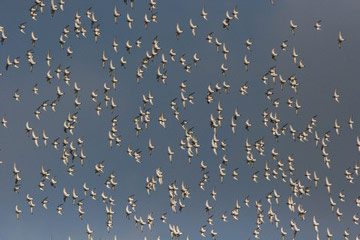
Golden Plover © Peter Twist
The Atlas map shows that Golden Plovers are scattered widely across the county during winter. Local birds leave their breeding grounds and move to the British coasts, France and Iberia, to be replaced by immigrants from Iceland, most of whom winter in Ireland with some in western Britain, and from Scandinavia and possibly Russia (Migration Atlas). They have long been known for their propensity to occupy the same groups of fields every winter, and seldom visit other sites (Coward 1910, Boyd 1946). They normally quit the moorland for the winter, and many of the occupied tetrads on the map are from birds that have returned early to their breeding areas. The county bird reports have noted that some Golden Plovers have considerably advanced their return dates, from mid-March during the 1990s to 24 February 2000, 17 February 2001, 9 January 2002, 18 January 2003, 11 February 2004, 9 February 2005 and 10 February 2006.
By far the most favoured site, holding perhaps half or more of the county’s birds, is Frodsham Marsh, as it has been for over forty years; in the 1960s it was not unusual to find winter flocks up to 1,000 birds there (Bell 1967). During this Atlas period, there were reports of seven flocks of 1,000 or more, all in the area of Frodsham or Hale on the opposite bank of the Mersey, with maxima of 1,300 on the north side at Hale Marsh (SJ48W) on 6 February 2005, and 4,000 on the south side at Frodsham Marsh (SJ57E) in January 2006. Elsewhere, the highest counts were 360 birds in 2004/ 05, roosting next to boats in the Heswall gutter (SJ28K) and 400 birds on 17 February 2005 at Ashley (SJ78S), which was one of their favoured sites mentioned by Coward, still in use one hundred years later. Most birds were in much smaller flocks, with a median size of 40 birds. They often form mixed flocks with Lapwings, and sometimes Fieldfares, but try to avoid Black-headed Gulls who often wait for the plovers to extract worms then rush in to steal the food. This kleptoparasitism drives Golden Plovers and Lapwings to feed at night, provided that there is sufficient moonlight, usually in different fields from their daytime haunts (Gillings et al 2005).
This is not normally an estuarine species, except in hard weather, with only 10-15% of the winter population found on coastal mudflats (Migration Atlas), but they feed in inland fields, mostly on earthworms and other soil invertebrates. Nearly two-thirds of the 71 submitted habitat codes were farmland, 26 of them improved grassland, with only one on unimproved grassland, and six each on stubble, tilled land and mixed grass/ tilled land. These proportions are similar to those for Lapwing, except that Golden Plovers are significantly more likely to be found on improved grassland and less likely to be on unimproved grassland than Lapwings: this seems surprising in view of Golden Plovers’ adherence to long-established feeding sites, many of them pre-dating the chemical era of modern agriculture and the establishment of lush grass. The remainder of the habitat records were grass moor with heather (C3) in three of the hill tetrads, one on grazing marsh at Inner Marsh Farm, three each of small waterbodies and sand quarries, one open shore (a small flock of four birds at Hoylake), and 4 records of saltmarsh and 11 habitats with estuarine codes.
Since the 1980s, there has been a substantial shift of wintering Golden Plovers to the east of England, perhaps in response to the warming climate, with more birds on arable fields and estuaries and fewer on grassland (Gillings et al 2006). There has been little change in the flocks at the county’s main site, implying a likely reduction at sites that are not regularly monitored, although this has not been noted in the records submitted to the annual bird reports. Revisiting all the areas mentioned by Coward and Boyd would make an interesting and worthwhile little project.
Sponsored by Dr J. D. Atkinson

